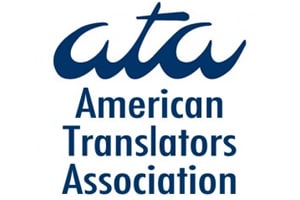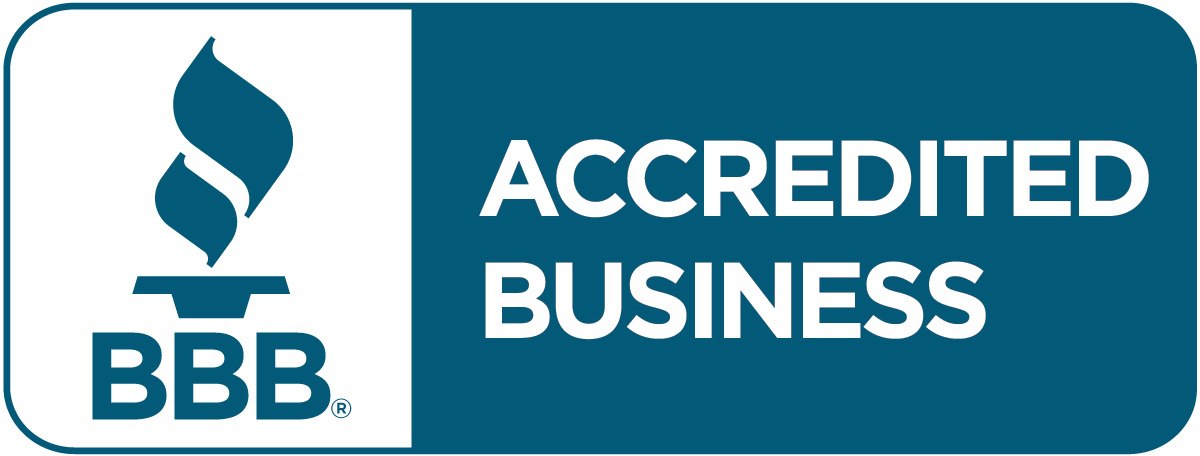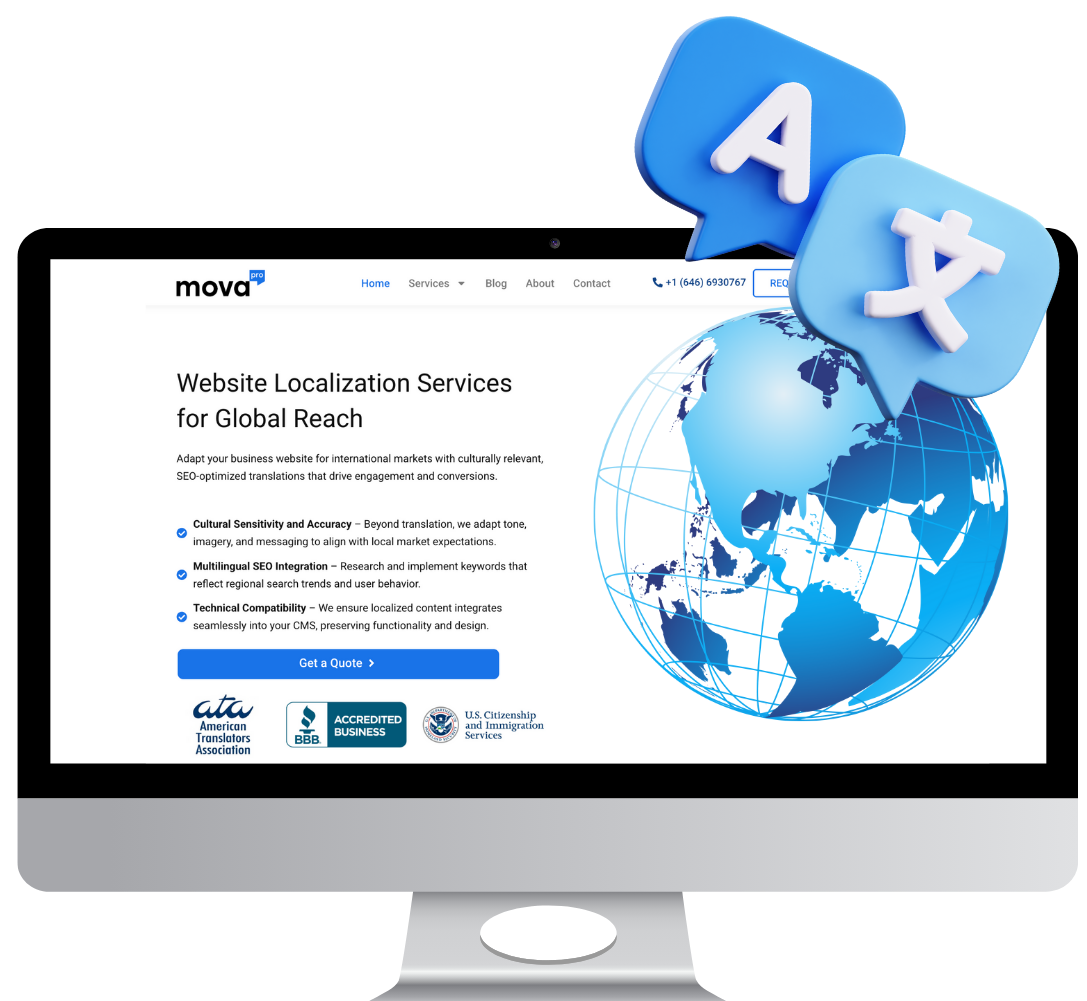Website Localization Services for Global Reach
Adapt your business website for international markets with culturally relevant, SEO-optimized translations that drive engagement and conversions.
- Cultural Sensitivity and Accuracy – Beyond translation, we adapt tone, imagery, and messaging to align with local market expectations.
- Multilingual SEO Integration – Research and implement keywords that reflect regional search trends and user behavior.
- Technical Compatibility – We ensure localized content integrates seamlessly into your CMS, preserving functionality and design.




The Key Advantages of Using Our Website Localization Services
Cultural Adaptation
We refine language, tone, and visuals to align with local preferences, ensuring your content resonates with global audiences.
SEO Optimization
Our team researches and integrates region-specific keywords to improve search rankings and maximize visibility in local markets.
UX Enhancement
We adapt layouts, formatting, and interactive elements to provide a seamless and engaging user experience across different languages.
Request a precise quote now!
Localization of your website is a game-changing step that can transform your digital presence from local to global. When you’re ready to expand your business internationally, you’ll need more than just basic translation – you need comprehensive website localization services that adapt your content for different markets. Your success in reaching international audiences depends on how well your website resonates with local cultures, customs, and preferences. Through professional website localization services, you can ensure your digital content speaks directly to your target audience, making them feel at home while browsing your site, regardless of their geographical location.
Core Website Localization Elements
While adapting your website for international markets, you need to focus on several key elements that make your digital presence effective across cultures. Your website localization services should encompass content translation, cultural adaptation, technical modifications, and local SEO optimization. According to recent studies, 76% of online shoppers prefer to buy products with information in their native language, making these elements crucial for your global success.
Language Translation Process
An effective website localization process begins with professional translation of your content by native speakers who understand your industry. Your content undergoes a systematic approach including initial translation, editing, and quality assurance. Research shows that 40% of consumers will never buy from websites in other languages, highlighting why you need accurate, nuanced translations that maintain your brand voice while speaking to local audiences.
Cultural Adaptation Strategies
Translation alone isn’t enough for your global success. Your website needs thorough cultural adaptation, including adjusting images, colors, and symbols to resonate with local audiences. Studies indicate that 90% of consumers are more likely to trust websites that show cultural awareness, making this step vital for your international market presence.
Localization experts help you navigate cultural sensitivities by adapting your content to local preferences and customs. You’ll need to consider everything from payment methods to social media integration, as these elements vary significantly across markets. For instance, while PayPal might be popular in Western countries, you might need to integrate local payment systems like Alipay for the Chinese market, where 54% of online transactions use this platform.
Technical Aspects
You need to consider various technical elements when implementing website localization services. From character encoding and content management systems to responsive design that works across different languages, these technical foundations ensure your localized website performs flawlessly. Your website’s architecture must support multiple languages while maintaining optimal loading speeds and user experience across all regions.
Multilingual Design Components
Between choosing the right fonts that support multiple character sets and implementing flexible layouts that accommodate different text lengths, your design must be adaptable. Your website needs to handle both left-to-right and right-to-left text directions, maintain proper spacing for different scripts, and ensure that images and icons are culturally appropriate for each target market.
International SEO Implementation
Multilingual SEO requires careful planning and implementation of hreflang tags, country-specific domains, and localized keywords. Your website needs proper URL structures, geo-targeting settings, and market-specific content optimization to rank effectively in local search results. Research shows that 76% of online shoppers prefer to buy products with information in their native language.
But international SEO goes beyond basic translation of keywords. Your strategy must include local link building, regional content calendars, and market-specific meta descriptions. You’ll need to consider local search engines beyond Google – like Baidu in China or Yandex in Russia – each with their own ranking factors and optimization requirements. Data indicates that websites implementing comprehensive international SEO strategies see an average increase of 47% in global organic traffic.
Market-Specific Considerations
It’s imperative to understand that your website localization strategy must align with specific market requirements and user expectations. When adapting your digital presence for different regions, you’ll need to consider various elements such as payment methods, shipping options, and local regulations. Your success in international markets depends on how well you can integrate these market-specific elements into your localized website.
Regional User Experience
Market-specific user experience adaptations can significantly impact your website’s performance in different regions. You’ll need to consider factors like loading speeds, mobile responsiveness, and local navigation preferences. Research shows that 74% of users are more likely to return to websites that offer native language support, making it vital for you to optimize the user experience according to regional expectations.
Local Digital Standards
An understanding of local digital standards is fundamental to successful website localization. You’ll need to ensure your website complies with regional technical specifications, data protection laws, and accessibility requirements. Studies indicate that 92% of global consumers prefer to shop on websites that display prices in their local currency.
Due to varying digital infrastructure across different markets, you’ll need to adapt your website’s technical specifications accordingly. This includes considerations such as popular local payment gateways, preferred hosting solutions, and regional content delivery networks. Your website localization strategy should account for local internet speeds, commonly used devices, and preferred browsers to ensure optimal performance in each target market.
Website Content We Localize
Why Choose Our Website Localization Services?
- Cultural Precision, Not Just Translation – We adapt your content to match the tone, values, and expectations of different regions, ensuring that your brand feels local, not foreign.
- SEO That Works Everywhere – Our localization includes keyword research and optimization, making sure your site ranks well on search engines in every market you enter.
- User Experience Comes First – From navigation to calls-to-action, we fine-tune every aspect of your site to match the preferences and habits of your target audience.
Expanding your website’s reach? Let us help you grow your audience with professional website localization tailored to your business needs.
FAQs: Website Localization Services
What types of websites do you localize?
We localize business and corporate websites, including landing pages, product descriptions, service pages, and blog content. Our focus is on general business sites rather than e-commerce or highly technical platforms.
How does website localization differ from simple translation?
Localization goes beyond translation by adapting content to fit cultural, linguistic, and regional preferences. This includes adjusting tone, imagery, and even layout to ensure the website feels natural to local audiences.
Can you optimize my website for local search engines (SEO)?
Yes! We localize keywords, meta descriptions, URLs, and other SEO elements to ensure your site ranks well in target markets.
How long does the localization process take?
The timeline depends on the size of the website and the number of target languages. Most projects are completed within 5 to 10 business days, but faster turnarounds are available for smaller sites.
Which languages do you offer for website localization?
We offer localization in Spanish, French, German, Italian, Chinese (Simplified and Traditional), Russian, Ukrainian, and other popular languages.
How do you ensure my website maintains brand consistency across languages?
Our localization team works closely with your existing brand guidelines, ensuring tone, messaging, and style remain consistent across all language versions of your website.
How to Get Started with Website Localization
We make it easy to localize your website and expand your reach to international audiences. Here’s how the process works:

1. Submit Your Website or Content
Share your website URL or upload specific pages and materials for localization. We handle full-site localization or individual sections based on your project needs.

2. Get a Quote & Project Timeline
Receive a detailed quote within 24 hours after we analyze your content. We’ll outline the project scope, turnaround time, and ensure the timeline aligns with your deadlines.

3. Localization, Review & Testing
Experienced linguists and UX specialists localize your content, adapting it for cultural relevance and engagement. Internal reviews and testing ensure accuracy and functionality.

4. Delivery & Post-Launch Support
Receive the localized website or content ready for launch. We provide ongoing support for updates, revisions, and future localization needs to keep your site performing globally.
Need ongoing website updates? We offer flexible maintenance services to keep your localized content fresh and relevant.
Quality Assurance
Many aspects of website localization services require rigorous quality control to ensure your digital content meets the highest standards. Your localized website undergoes multiple rounds of testing, including linguistic validation, functional testing, and cultural appropriateness checks. With our comprehensive QA process, you can be confident that your website will perform flawlessly across different markets, maintaining your brand’s professional image while engaging international audiences effectively.
Translation Accuracy Checks
Behind every successful localized website is a thorough translation verification process. Your content goes through multiple review stages where native-speaking experts examine the accuracy of translations, ensuring terminology consistency and proper context adaptation. Statistics show that 75% of consumers prefer to buy products in their native language, making accurate translation a key factor in your website’s success.
Cultural Compliance Review
Behind your website’s cultural adaptation lies a complex review process that ensures your content resonates with local audiences. Your digital presence undergoes careful examination for cultural sensitivities, local customs, and market-specific preferences. Research indicates that 86% of localized websites see increased engagement when they incorporate cultural considerations.
Indeed, the cultural compliance review process extends beyond basic translation to encompass every aspect of your online presence. Your images, colors, symbols, and even navigation patterns are evaluated through a cultural lens. This comprehensive approach helps you avoid potential cultural mishaps that could damage your brand reputation, as studies show that 56% of consumers place more importance on the ability to obtain information in their native language than on price.
Implementation Process
Once again, implementing website localization services requires a strategic approach to ensure seamless integration. You’ll need to identify target markets, analyze cultural preferences, and select appropriate technologies. Using comprehensive localization tools and platforms can streamline your process, making it easier to manage multiple language versions while maintaining consistent branding across all markets.
Project Timeline Management
Across your website localization journey, effective timeline management becomes your cornerstone for success. You’ll need to establish realistic deadlines for content translation, technical implementation, and quality assurance testing. Breaking down the project into manageable phases helps you track progress and ensure timely delivery, typically spanning 8-12 weeks for medium-sized websites.
Resource Allocation
Above all, proper resource allocation determines the success of your website localization project. You’ll need to assess your requirements for linguistic experts, technical specialists, and quality assurance teams. Statistics show that well-planned resource allocation can reduce localization costs by up to 30% and accelerate project completion by 25%.
But there’s more to consider when allocating resources for your website localization services. You’ll need to factor in ongoing maintenance, regular content updates, and continuous quality monitoring. This includes budgeting for translation memory tools, which can save up to 60% on future translation costs, and investing in automated testing tools to ensure consistent quality across all language versions.
Performance Metrics
After implementing website localization services, tracking key performance indicators becomes vital for measuring success. Your localized website’s effectiveness can be monitored through various metrics, including bounce rates, conversion rates, and time spent on page. Studies show that properly localized websites experience up to 70% higher retention rates compared to non-localized versions, demonstrating the direct impact on your business growth.
User Engagement Analysis
Across different market segments, you can analyze how visitors interact with your localized content. Your analytics will reveal valuable insights about user behavior, preferred content types, and navigation patterns. Data shows that users spend 2.5 times longer on websites presented in their native language, highlighting the importance of effective website localization services for engagement.
Market Penetration Tracking
By monitoring your market reach through geographic data and local search rankings, you can assess the effectiveness of your website localization services. Your visibility in target markets can be measured through local SEO performance, social media engagement, and regional traffic growth.
Performance tracking helps you understand the ROI of your localization investment. Your localized website’s success can be quantified through multiple indicators: increased local market share, higher conversion rates (typically 20-70% higher for localized sites), and improved customer satisfaction scores. These metrics enable you to refine your localization strategy and maximize your global market presence.
To wrap up
Ultimately, when you choose professional website localization services, you’re investing in your business’s global future. Your success in international markets depends on how effectively you can connect with local audiences, and that’s exactly what these services provide. By adapting your website’s content, design, and functionality to meet local preferences and cultural expectations, you position your business for global growth. When you partner with experienced localization experts, you ensure your digital presence resonates with your target markets, helping you build trust and drive conversions across borders.



